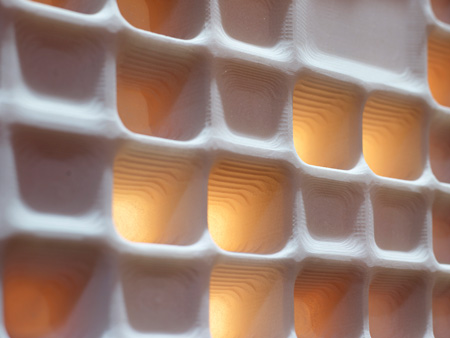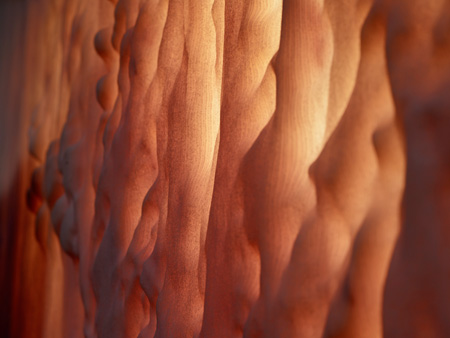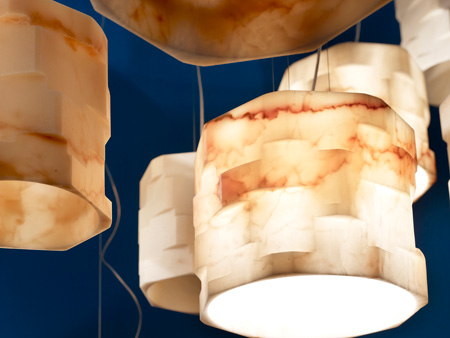13 Aprile 2012
English
Wonders

Marble slab Vigaria, Luce e Materia, Marmomacc 2011, Solubema
Metamorphosis. Within Marmomacc 2011, Raffaello Galiotto is busy for brands Merbes-Sprimont (Belgium) and Solubema-Etma (Portugal) with the project “Light and matter”, aimed at giving sense and a formal evidence to the extreme difference of two kinds of matter from the natural world of rocks: Black marble from Belgium and Vigaria marble from Portugal.
Such an exhibition renews the challenge that exists between matter and energy and the talents that each one of these is able to “release”.
«Matter – as Henri Focillon would say – entails a certain destiny or, if you wish, a certain talent. It has consistency, color, grain. It is form, as we say, and for this reason, it recalls, limits or develops the life of forms in art.
It is chosen, not only for its working convenience, or, to the extent in which art serves life’s needs, for the validity of its use; but also because it lends itself to special treatment, because it gives certain effects. (…) But it is useful to observe that this talent is not blind determinism, since such well-characterized, suggestive and demanding matter regarding forms of art upon which it exerts a certain attraction, is, in return, profoundly modified by it.
This is how artistic matter and natural matter are separated, even though they are united by a strict formal convenience. A new order is established. They are two ruling entities, even if artifices and the factory do not intervene. The wood of the statue is not the wood of the tree; the sculpted marble is no longer the marble from the mines; after melting, gold is a new metal; having been fired and put to use, bricks are not related to the clay in the clay bed. The colors, the epidermis, all the factors that visually interact with touch, have changed. Things without a surface, hidden behind the bark, buried in the mountain, blocked in the nugget, embedded in the mire, have separated from chaos: they have a skin, they cling to space and welcome light, in its turn a working agent. Even if the treatment they have undergone has altered the balance and natural relationship between the parts, the visible life of matter has been transformed.»
If form – as Focillon suggests – is the “how of matter” freed from the realm of nature, then the designer is the medium, the demiurge capable of giving “shape” to matter itself, making it appear “like this” and not “like that”. This, undoubtedly, is Raffaello Galiotto’s starting point in his project “Light and Matter”. The aim of the designer is to create mutation, secure transformation and even the metamorphosis of stone matters. Unlike previous occasions, here we see Galiotto working rather like an artist, as a creator of sensorial and illusive experience, than like a designer focused on defining a functional series of products.
However, we know that the forms of matter are not just the high points of a graphic scheme or the surface of a virtual image.

Marble slab Vigaria, Luce e Materia, Marmomacc 2011, Solubema
They take tangible shape and consistency starting with the modeling of the atoms, they take on tactile and visual shapes, they concretize – above all – in a three-dimensional space occupying it and rendering it experiential. In this three-dimensional space, which organizes and relates forms and materials, we find Galiotto’s second point of research, capable of “staging” and turning the first one into a show.
In the three-dimensional space in which we move the human body is a object among “other” objects, but it’ s also the one which sees the artifacts, measures them, touches them and turns them into personal experiences, emotions and mental associations. Space and objects – through the dialectic relationship of empty and full, of materiality and immateriality, density and weight, shadow and light – hand over to us their aura to entice the senses and produce sensations.
Mirabilia. The exhibition “Light and Matter” intends to bring back the concept of the Wunderkammer (literally “cabinet of wonders), created in the 16th-18th centuries by important European collectors in order to keep, study, display and above all “enjoy” objects which evidently possessed intrinsic peculiarities.
Scientific interest, a love for the exceptional, the strange – typical of the Enlightenment period – to be found at the very beginning of each Wunderkammer, have always met with the innate human drive to possess objects capable of awaking wonder. These are not necessarily precious, but they certainly are extraordinary objects that come either straight from nature (naturalia) or are created by man (artificialia).
The uniqueness or originality of the shape, the rare find, the dimensional unicity, the exotic origin, the precious craftmanship, etc., were the typical elements that made of the objects of the Wunderkammer a gathering of wonders to keep and exhibit.
Possessing a Wunderkammer to show privately to friends and important visitors was the prerogative of the elite: aristocrats and kings, distinguished scientists or scholarly and wealthy men.
At Marmomacc 2011, “Light and Matter” revives the aura of a contemporary lithic Wunderkammer – however “democratized” and aimed at a vast and cosmopolitan audience – which is directly enjoyable while unveiling the unusual and the magical involved with the life of two very special marbles.
The ultimate protagonist is light, which presents two very special stones – the previously mentioned Black marble of Belgium and Vigaria marble of Portugal – by playing with their skin and by presenting all the factors which act upon the optical senses, through the various imprints performed with sophisticated and advanced manufacturing software.
The Wunderkammer welcomes visitors like a continuous, although thematically segmented and pronounced path, with very particular spaces and artifacts, offering an experience which Is both conceptually useful and emotional.
Illusive figurativeness. The opening rooms of “Light and Matter” are marked by a number of stone surfaces that reflect, reverberate, get deformed, owing to the use of Black marble from Belgium.
As with cinema and theater, which require areas of shadow (if not complete dark) against lit spaces, where the action takes place, so is the incipit of such a spacial device announced by a dark background and a dim atmosphere that invites fruitive concentration.
On the walls – or in the center of the rooms – the unusual and “wonderful” objects exhibited are in fact a series of highly polished marble artifacts. The narration by “episodes” that develops along the walls tells the metamorphosis of the Black Belgium marble – solid, uniform, absolute matter – which in this place is seeking for the “other” presence, a “speaking” existence, at the moment in which it “meets the lights”.
The boundaries between the exhibition surface and the objects on display, between the lit and shadowed areas, are quite softened (or contrasted) in these first rooms in order to grant a sort of magical evidence on the artifacts – and predispose them to relationships and to the fruitive relationship with the visitors.
When the direct and directed light in these rooms hits the marble surfaces it traces their profiles, it highlights their projections and depths, it stresses the optical deformation of the reflected images as with an illusive and disorienting mirror effect.
This sofisticated use of materials, that reflect like replicative and widened “screens” ready to bring to life original spacial configurations, suggest and interprets numerous evocative visual sensations tied to the figurative tradition of the actualized past and also of the present : from the mysterious convex mirror painted with microscopic meticulousness by Jan Van Eyck in the famous Arnolfini Portrait (1434) of a married couple, to the “photographic distortions” – illusionistic and estranged – created at the beginning of the 20th century by André Kertész. But if these artists have transposed both the mirrored surfaces onto an abstract and intangible plane of two-dimensional representation (pictorial or photographic), on the other hand the creative act presented in “Light and Matter” has restored its own materiality and three-dimensionality to it through the sofisticated use of innovative technology which is “reshaping” them into true marble objects.

Hangoing lamp, marble Vigaria, Luce e Materia, Marmomacc 2011, Solubema
The first rooms in “Light and Matter” are also establishing stimulating connections with contemporary artistic experiments. Shapes of unusual, curved, enormously expansive forms, coated with reflective material (either natural or artificial) represent, in fact, the stylistic signature of the artist and architect Anish Kapoor, who for years has been consistently researching and experimenting with alternative and never before crystallized spacial experiences. Many of his installations seem to share the incipit of the fruitive path conceived of by Galiotto not only the virtuosistic search for reverberated and deformed background devices, but also the penchant for dark grey and black tones, hinting to the return to an immaterial and intangible beyond.
Translucence. The second narrative “tempo” on the path of “Light and Matter” draws from the seductive dizziness of the stone “transparency”.
Far from the thickened layers of the rocky deposits, or from the monoliths removed from the quarry front, in the creative hands of Raffaele Galiotto the Vigaria marble from Portugal becomes “warm and seductive”, as the light running through its thickness reveals, beyond the intrinsic mineral essence of the stone, the form of the artifice and the modeling impressed in the matter.
In the final section of the “Light and Matter” exhibit the visitor faces a narrative path where stone matter confronts and creatively deepens the concept of “shining through”, different from the “surface shining” of the Nero Belgium marble.
Cylinder artifacts, figurative surfaces, excavated coplanar panels stand out for the allurement of the optical phenomenon of translucence, where light pervades the thickness of the stone transferring to the latter the magic value of its distinctive qualities.
The active action of light, which reverberates with colorful energy, thus causing stone – specifically the Vigaria marble from Portugal – to become a luminous, iridescent, illusory source of light that is magically restored to the space all around.
The essay is from:
Alfonso Acocella, “Mirabilia”, in Raffaello Galiotto (a cura di), Luce e materia, s.l., Solubema, 2011, pp. 96.
